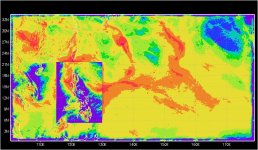jbasconcillo
New member
I have some concerns on running long-term simulation over nested domains. For example, if I will simulate 3-month rainfall using the larger domain (D01) in the attached picture, I am essentially excluding the effect of other ENSO regions (beyond 180E) and the influence from the Southern hemisphere and extratropics in the Northern hemisphere.
1. In order to perform seasonal runs and capture seasonal climate, is it better to use global domain as D01 and the designate D02 as the inner domain to capture large-scale processes influencing the regional climate?
2. What does it mean by "the initial condition is updated every 6 hours"? If I use initial conditions from December 1-31, the model will use the initial condition on December 1_00:00 for timestep 1, then use the initial condition on December 1_06:00 for timestep 2 but will also consider the results from timestep 1.
My concern is if I am going to run 3-month simulation using updated 6-hourly data, then, essentially, the model is using the initial condition from timestep 1 but also updating itself with the new input initial conditions. Is this the correct interpretation?
1. In order to perform seasonal runs and capture seasonal climate, is it better to use global domain as D01 and the designate D02 as the inner domain to capture large-scale processes influencing the regional climate?
2. What does it mean by "the initial condition is updated every 6 hours"? If I use initial conditions from December 1-31, the model will use the initial condition on December 1_00:00 for timestep 1, then use the initial condition on December 1_06:00 for timestep 2 but will also consider the results from timestep 1.
My concern is if I am going to run 3-month simulation using updated 6-hourly data, then, essentially, the model is using the initial condition from timestep 1 but also updating itself with the new input initial conditions. Is this the correct interpretation?

